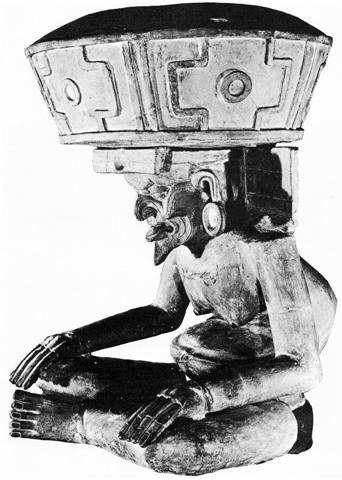|
TRANSLATIONS
Next page:
This god was located at the center of the world. This center is where the ruler should be. Only secondarily can the center be a geographic or temporal location. He does not need to be at the earth's core or at midsummer. What matters, instead, is that he is old (he is Huehueteotl, has the 'garment' of the old one). From being young and 'green' he quickly developed into a member to rely upon - a 'pillar' - for the society. He became dry and hard. When this process has continued far enough he will be the eldest and then it will be his turn to dive down at the horizon in the west. His body will return into mother earth and his spirit will soar up to the sky like a flame. In youth there are 3 fingers which nourish him (kai). At 'noon' he is forced to stabilize, he is initiated to the mysteries of being a mature person and from then on he no longer has his top flame blazing freely but instead it has become a dry rigid Y:
In Aa1-30 the arm extending forward comes from a low position, and the arm is a separate entity, it could be the fire (ahi) which leaves him. Sun has returned to earth (hakaturu ki te henua). The blasphemy (hakaturou) of Metoro (and Bishop Jaussen) could refer to the thumb. The thumb is not on the hand until noon. It is a mature and functioning member in front only when sun has become mature. The contact with mother earth at the horizon in the west can be interpreted as an important part of the regeneration necessary to create a new sun (a son). A heathen idea well worth the appellation hakaturou. If we count planets without stopping at 20, then Aa1-26 will be a Sun day and Aa1-30 a Jupiter day, which seems to be quite in order and reasonable. At noon Sun should be the main person without any 'mask' in front of him. But this is his last appearance in his natural state, it is station number 26. When his spirit is leaving him (Aa1-30), he has the Jupiter position. If we instead count with 21 being position number 1 (etc), then Aa1-26 will be a position of Moon, which also is congruent with ahi, because in the process of initiation Sun must 'die' to be reborn again - he must meet with his female partner. He must experience the fundamental facts of life and death. Ka puhi hoki ki te ahi seems to mean the revival from a temporary death, 'once again blow on the fire'. Aa1-30--31 will be at Venus and Saturn, with a new fire once again being alighted at Aa1-32:
Then follows a toga with Y at a Moon position. At left is a slim waning moon crescent. Moon indeed should close the 'season', it is glyph number 13 counted from Aa1-21. The reversed tapa mea in Aa1-34 has only 5 feathers. 34 = 29 + 5, but that is hardly relevant - the feathers are not equal in size and the subject is the sun and not the moon. Mars reappears at Aa1-34. Where has he been during the previous day? He has a position after the Moon (of course). But Moon sets the limits for the Sun, and Mars has the task to return the light, which does not seem to result in proper tapa mea signs. Not even the fat Aa1-21 is a good sign, because there is a break in its front middle:
But the table above is wrong. Either we continue counting without a break at 20 or not. If we count with a break at 20, then the table must be:
Or else we count without break at 20, in which case the table will be:
Why should we make a break at 20? This rule is for the month, not for the day. If we should have a break, I guess it ought to be at 27 (= 3 * 3 * 3 = the latitude of Easter Island):
A break at 27 will give the same planetary positions from Aa1-28 as a break at 20. |














